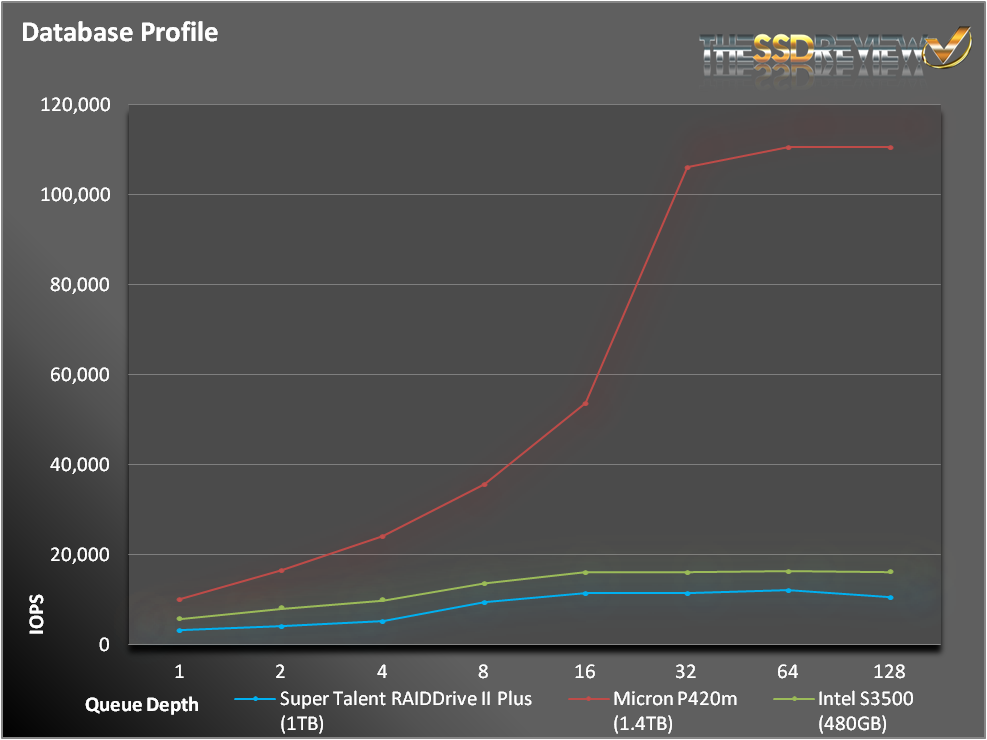SERVER PROFILES
While synthetic workloads do a great job of testing the underlying technology and reporting easy to understand results, they aren’t always indicative of how the drive will be used by the end-user. Workloads that simulate enterprise environments try to bridge that gap without being overly complex.

The database profile is 8K transfers, and 67% percent of operations are reads.
The fileserver profile is based on an 80% read/20% write mix. Its made up of block sizes from 512 to 64K, each making up a different percentage of the access pattern. The pattern is: 512 bytes=10%, 1k=5%,2k=5%, 4k=60%, 8k=2%, 16k=4%, 32k=4%, 64k=10%.
The webserver profile is similar to the fileserver profile, but has some additional 128K and 512K accesses thrown in for good measure. Additionally, the profile is 100% read.
Similar to our other tests, the RAIDDrive II Plus is not only not a match for the P420m, it gets beat in most areas by a single Intel S3500.
FINAL THOUGHTS
With the RAIDDrive II Plus, Super Talent delivered a PCIe x8 GEN2 storage device that can reach speeds of over 3.2GB/s. This is a bump from the non-Plus version, which only hits 2.8Gb/s. This is a product that is aimed at enterprise customers who want high performance, but don’t have the space for banks of SSDs.
We have to give Super Talent credit for their unique way of connecting their modular SSDs on a single board. By using the additional pins on USB 3.0, they were able to route power and the TX and RX pairs used for SATA across a USB connector. This allowed them to use readily available parts which reduced their design times and cost. This is an interesting alternative to other high speed, high density connectors that we see on other products.

We also felt very familiar with this product due to the LSI 2108 RAID-on-Chip and Areca firmware and software due to our extensive use of them on other products. In fact, this entire product behaves just like a RAID card with 8 SSDs, because, essentially, that’s what it is. Using a RoC has a lot of benefits. You get all sorts of management capabilities that should fit into existing monitoring software, which is more extensive than for any other PCIe storage device we have tested. Some users may also like the fact that you are able to control every little aspect of how the RoC performs, so that you can dial in different configurations and performance.
When looking at performance, the RAIDDrive II Plus does a good job of delivering sequential performance. Even in its worse-case, it is similar to the Micron P420m. If you use large block sizes and tweak the configuration, you can get close to 3GB/s, which is well above what the P420m can offer.

Unfortunately, once you stray from large block sequential reads and writes, the performance falls apart. Any amount of random or small block accesses drops the performance to that of a single SSD. In many of the tests, a single Intel S3500 was able to outperform the RAIDDrive II Plus.
Ultimately, a major component of the buying decision is price. Super Talent did not release a retail price for this product, but we did find web pricing on the older RAIDDrive II. It was consistently in the $4/GB range which is actually higher than the Micron P420m when priced through similar channels.
Overall, this is only a viable product if you need really high sequential speeds, do not care about random performance, and do not have the room for a RAID card and 8 standalone SSDs. We really wanted to like this drive, but performance and price are what will drive customers away.
 The SSD Review The Worlds Dedicated SSD Education and Review Resource |
The SSD Review The Worlds Dedicated SSD Education and Review Resource | 
Any warranty mentioned? My big concern is the heavy use of those mini daughter card connectors. They tend to be susceptible to thermal expansion/contraction which can cause failures/corruptions. Also, I couldn’t see any supercaps on this unit.
I don’t have warranty information, my apologies. I almost included information about the USB connectors lifespan because of possible fretting, but decided to leave it out because the boards are incredibly secure. In higher shock and vibration environments (greater than a server rack), it could be a concern.
It’s not the USB connectors I worried about but those tiny daughterboard connectors.I didn’t see any screws holding the memory/controller card pairs together.